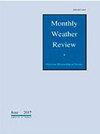A Climatology of Convective Precipitation over Europe
IF 2.8
3区 地球科学
Q3 METEOROLOGY & ATMOSPHERIC SCIENCES
引用次数: 0
Abstract
The annual, seasonal, and diurnal spatiotemporal heavy convective precipitation patterns over a pan-European domain are analyzed in this study using a combination of datasets, including the IMERG precipitation rate product, E-OBS ground-based precipitation gauge data, EURADCLIM climatological gauge-adjusted radar precipitation dataset, OPERA ground-based radar derived precipitation rates, and ERA5 total and convective precipitation products. ATDnet lightning data is used in conjunction with IMERG and EURADCLIM precipitation rates with an imposed threshold of 10 mm hr−1 to classify precipitation as convective. Annually, the largest convective precipitation accumulations are over the European seas and coastlines. In summer, convective precipitation is more common over the European continent, though relatively large accumulations exist over the northern coastal waters and the southern seas, with a seasonal localized maximum over the northern Adriatic Sea. Activity shifts southward to the Mediterranean and its coastlines in autumn and winter, with maxima over the Ionian Sea, the eastern Adriatic Sea, and the adjacent coastline. Over the continent, 1 – 10% of the total precipitation accumulated is classified as convective, increasing to 10 – 40% over the surrounding seas. In contrast, 30 – 50 % of ERA5 precipitation accumulations over land is produced by the convective parameterization scheme and 40 – 60% over the seas; however, only 1% of ERA5 convective precipitation accumulations are from rain rates exceeding 10 mm hr−1. Regional analyses indicate that convective precipitation rates over the inland mountains follow diurnal heating, though little to no diurnal pattern exists in convective precipitation rates over the seas and coastal mountains.欧洲对流降水气候学
本研究采用多种数据集,包括 IMERG 降水率产品、E-OBS 地面降水量表数据、EURADCLIM 气候学量表调整雷达降水量数据集、OPERA 地面雷达衍生降水率以及 ERA5 总降水量和对流降水量产品,对泛欧区域的年度、季节和昼夜强对流降水时空模式进行了分析。ATDnet 闪电数据与 IMERG 和 EURADCLIM 降水率结合使用,将降水划分为对流降水的阈值为 10 毫米/小时-1。每年,欧洲海域和海岸线上的对流降水累积量最大。夏季,对流性降水在欧洲大陆上空较为常见,但在北部沿岸水域和南部海域的累积量相对较大,亚得里亚海北部出现季节性局地最大降水。秋冬季节,降水活动向南转移到地中海及其海岸线,在爱奥尼亚海、亚得里亚海东部和邻近海岸线上空出现最大降水量。在大陆上,累积降水总量的 1 - 10% 属于对流降水,在周边海域则增加到 10 - 40%。相比之下,对流参数化方案产生的对流降水占ERA5陆地累积降水量的30%-50%,占海洋累积降水量的40%-60%;然而,ERA5对流累积降水量中只有1%来自超过10毫米/小时-1的降雨率。区域分析表明,内陆山区的对流降水率随昼夜温差变化,而海洋和沿海山区的对流降水率几乎没有昼夜变化规律。
本文章由计算机程序翻译,如有差异,请以英文原文为准。
求助全文
约1分钟内获得全文
求助全文
来源期刊

Monthly Weather Review
地学-气象与大气科学
CiteScore
6.40
自引率
12.50%
发文量
186
审稿时长
3-6 weeks
期刊介绍:
Monthly Weather Review (MWR) (ISSN: 0027-0644; eISSN: 1520-0493) publishes research relevant to the analysis and prediction of observed atmospheric circulations and physics, including technique development, data assimilation, model validation, and relevant case studies. This research includes numerical and data assimilation techniques that apply to the atmosphere and/or ocean environments. MWR also addresses phenomena having seasonal and subseasonal time scales.
文献相关原料
| 公司名称 | 产品信息 | 采购帮参考价格 |
|---|
 求助内容:
求助内容: 应助结果提醒方式:
应助结果提醒方式:


